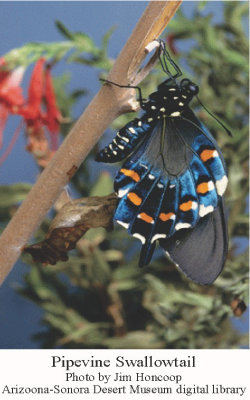
One of my favorite butterflies is the Pipevine Swallowtail (Battus philenor) which is common in the Tucson area. It is a large butterfly with a wingspan of about 3.5 inches. This butterfly ranges throughout the U.S. and Central America.
The upper side of the wings are black. Females have a row of whitish-blue to yellow checker spots on the hind wing. In males, the upper hind wing shades into bluish white. The underside of the wings are spectacular with orange, white, black, and blue checkers. The body is black with white and blue spots.
During breeding season, the male Pipevine Swallowtail patrols a territory, waiting for a female to arrive. After mating, the female lays several rust-colored eggs on the underside of a leaf which is later eaten by the caterpillar. The caterpillar, generally over two inches long is black with red spines.
The caterpillar feeds on the poisonous host plant, Aristolochia, also known as the pipevine, Dutchman’s pipe or birthwort. It contains the lethal toxin aristolochic acid. The caterpillars are immune to this poison, but it makes both the caterpillar and butterfly poisonous to predators (and humans).
 Southwestern pipevine is a prostrate vine, growing from a perennial tuber. In nature it is found along streams and dry washes from the desert up to the grasslands, in Arizona and Sonora. It can form mats of 3′ across, with the stems twining weakly. Its very unusual shaped flowers are brownish-red with a yellowish center. See photos here
Southwestern pipevine is a prostrate vine, growing from a perennial tuber. In nature it is found along streams and dry washes from the desert up to the grasslands, in Arizona and Sonora. It can form mats of 3′ across, with the stems twining weakly. Its very unusual shaped flowers are brownish-red with a yellowish center. See photos here
When the caterpillar reaches full size, it looks for a place to pupate in some sheltered place. The pupa stage of the butterfly, called a chrysalis, is brown or light green, depending on the surface they attach to. If a caterpillar pupates early in Summer, it emerges as a butterfly in a few weeks and mates. If it pupates in late summer or fall, it stays in its chrysalis through the winter, and the butterfly emerges in spring.
The butterfly feeds on nectar from flowers including milkweed plants. The butterflies serve as plant pollinators.
“Pipevine Swallowtails are a big help to other butterfly species without even trying. Because adult butterflies are poisonous to predators from all the pipevine they eat as caterpillars, most birds avoid them. Other butterfly species have developed mimicry. Mimicry is when one animal copies the look of another, and gains protection. Some species that mimic Pipevine Swallowtails include Eastern Tiger Swallowtail (females), Eastern Black Swallowtail, Spicebush Swallowtail, and Red-spotted Purple. None of these species are poisonous, but birds avoid them because they have the same color and size as Pipevine Swallowtails.” (Source)
Look for these beautiful butterflies this summer.
Note to readers: I have constructed a linked index to more than 400 of my ADI articles. You can see it at: https://wryheat.wordpress.com/adi-index/
You can read my comprehensive, 28-page essay on climate change here:
http://wp.me/P3SUNp-1bq

